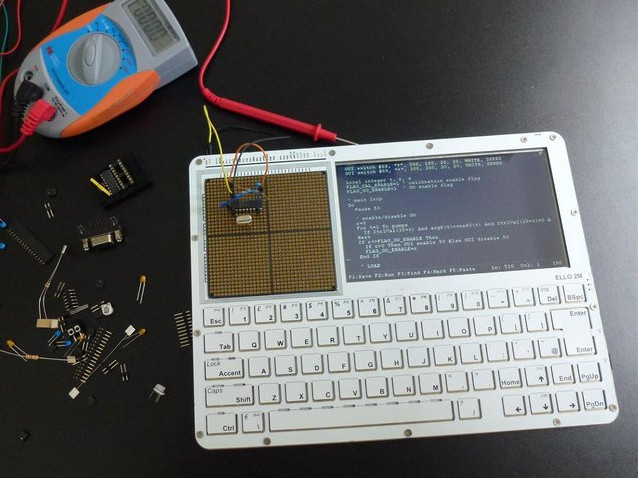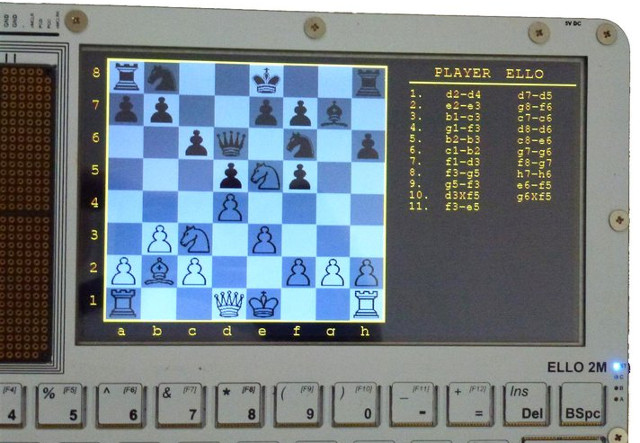The traditional way to play with electronics is to get a board (e.g. Arduino), a breadboard to wire components & sensors to the board, and a computer for programming. ELLO 2M combines all that into a single piece of hardware with a 7″ touchscreen display, a Microchip PIC32 micro-controller board, a solderless prototyping area made of PGA sockets, and a keyboard.
ELLO 2M hardware specifications:
- MCU – Microchip PIC32MX470 32-bit micro-controller @ 120 MHz with 128kB RAM (512kB RAM in the ELLO 2M “hacker” versions)
- Extra System Memory – Optional on-board serial non-volatile data RAM
- Storage – 3x micro-SD cards (one permanently built-in and two for removable storage); internal serial FRAM
- Display – 7″ LCD touch-screen panel with 800×480 pixel resolution
- Audio – Small speaker and buzzer
- Keyboard – Replaceable QWERTY keyboard
- Connectivity – 2.4GHz RF communication module with simple communication protocol
- Expansion – Expansion receptacle, electronic prototyping space with up to 1156 holes
- Misc – Real-time clock
- Battery – 4,500mAh battery for up to 12 hours of continuous operation (more in power-saving mode)
- Dimensions – six stacked circuit boards with 6.4mm total height without socket
ELLO 2M uses BASIC, which incidentally is the first programming language I first learned many years ago, but C language programming is also possible. More precisely ELLO runs MMBasic implementation released under a Creative Commons License. The project is also open source hardware with all design files released on github.
Konstantin Dimitrov, the project developer, has taken to CrowdSupply to raise funds for mass production. A $65 pledge will get you the six bare PCBs (shown in the video above), so that you can purchase and solder the components yourself, but most people may want an assembled version with price starting at $180 for Ello 2M Developer which does not include the prototyping area, and you’d need to pledge $240 to get Ello 2M Geek with the built-in prototyping board. You can also request your own custom keyboard panel-out for $550. Shipping is included in the prices, and delivery is scheduled for September 2016.
Via Liliputing and Geek

Jean-Luc started CNX Software in 2010 as a part-time endeavor, before quitting his job as a software engineering manager, and starting to write daily news, and reviews full time later in 2011.
Support CNX Software! Donate via cryptocurrencies, become a Patron on Patreon, or purchase goods on Amazon or Aliexpress







For all friends of the BASIC programming language (here a Basic to C converter):
http://www.bitkistl.com/2016/05/performance-benchmark-bacon-basic-vs.html
That thing on the shot is *not* Basic. Basic is a thing with line numbers and flat syntax. The only common it has with a real Basic is that it’s completely non-portable and specific to a single product, so a program written for a board with white silkscreen won’t work on a board with red silkscreen.
For all friends of the BASIC programming language….you really need to make new friends… Python or even C/C++…lol 🙂
There is some trace of micropython for PIC32
https://forum.micropython.org/viewtopic.php?t=691
So to ‘learn electronics’ & a badly outdated programming language you need to know enough to buy components for & solder together the kit, or pay $200. What is this good for other than geek nostalgia?
@onebir
Perhaps you’d be surprised to learn that soldering kits and learning outdated (even back then) languages was how some of us got into computers. As per the price, it’s not cheap in assembled form, that’s granted, but the DIY kit is perfectly reasonable. I’m considering getting one for my kids.
@blu
No it isn’t. 65 USD is just the PCB with no components. 180 USD with components, even if it’s assembled, is too much. An additional 60 USD just for the prototyping area is insane. I really like the idea, but the pricing is, at the very least, 100 USD too high.
@blu
Made sense *back then*, hope the kids enjoy it if you get one…
@lukasubo
Agreed, this would make more sense at a (sub) Raspberry Pi price point; PIC boards go for <$15, others for less.
Sure it isn’t cheap, but then it is not for people who count the cents. Because it is a unique system it will quickly become a high-priced collectable and I bet in a few years from now you would be lucky to find one on eBay.com for less than $1k. Noone will care about the $15 boards and Pi then.
@onebir
‘PIC boards’ can go for a low as their mass-market quantities dictate. Here’s a PIC board in somewhat more limited production quantities: http://www.digikey.com/product-detail/en/microchip-technology/DM320006/DM320006-ND/4500815
Notice the price. Sure, chips themselves cost peanuts. But low-run boards can be expensive. Not everybody can afford raspberry production facilities, or even Chaina mainland ties. As long as the product is not prohibitively expensive for what it offers (read: way above the market price for such things; and somehow I’m not seeing such devices for $15 on the market), then the price is reasonable.
Re BASIC, it was fine then for _learning_ purposes, and it’s fine now; it’s not like some new paradigm was invented in programming languages during the past 30 years.
What a great idea! Kind of reminds me of the educational electronics kits from the 90s but with a modern spin.
Count me in!